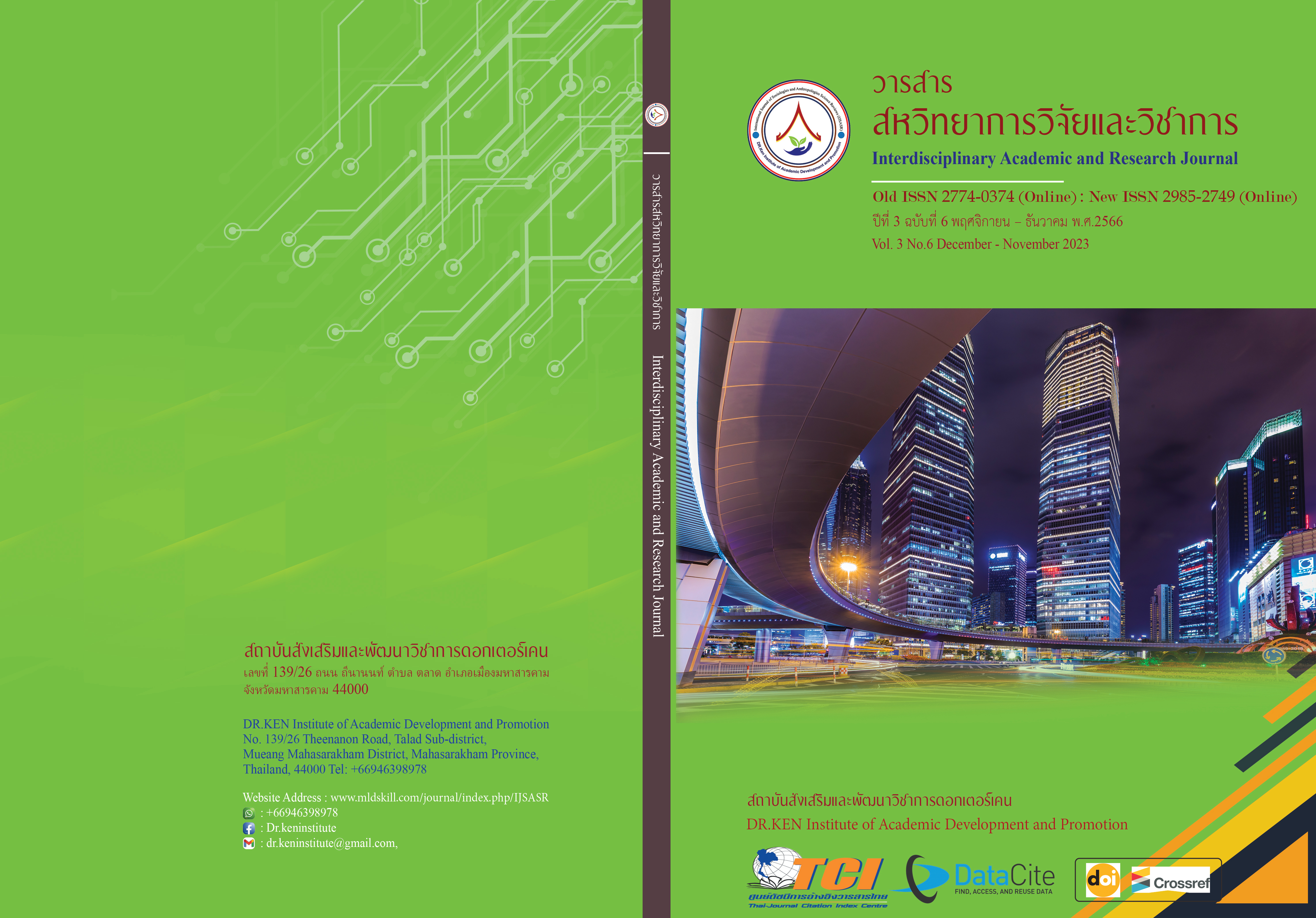Guidelines for Developing Creative Leadership for Supervisors of Various Departments Promote Non-Formal Education and Informal Education in Maha Sarakham Province
DOI:
https://doi.org/10.60027/iarj.2023.272569Keywords:
Guideline of the development;, Creative Leadership; , AdministratorsAbstract
Background and Aims: Educational institution administrators are the ones who play a very important role in leading to the efficiency of the educational institution and achieving the organization's goals. They are also those who greatly affect the behavior of individuals in the organization in terms of creating behavior and controlling individual behavior. Thus, this research aims to study the desirable current state of affairs and the essential needs of creative leadership of our target audience and to study ways to develop the creative leadership situation of the target group.
Methodology: The research is divided the research into 2 phases: Phase 1 studies the desirable conditions and needs of the current leadership of the target group; from the sample, there were 13 school administrators and 182 teachers, totaling 195 people randomly selected by simple random sampling. The tool used was a questionnaire. The statistics used in the research were frequency, percentage, mean, and standard deviation. and the necessary needs index. Phase 2: Guidelines for developing creative leadership of school administrators from 9 experts. The tool is a structured interview form and analyzes the content of the information obtained from the interview by interpreting and descriptive presentation.
Results: The current state of creative leadership of school administrators. Overall, the desirable condition of creative leadership of school administrators was at the highest level. The need for creative leadership was at the highest level. between 4.17 – 3.40 and guidelines for developing creative leadership of school administrators. The result of the suitability and feasibility assessment was at the highest level. All 19 guidelines for developing creative leadership for school administrators were obtained. which are 5 ways of being trustworthy, 4 ways of flexibility, 5 ways of imagination, and 5 ways of vision.
Conclusion: The research results show that the creative leadership of school administrators currently has a high level of desirability, needs at a level of 4.17 - 3.40, and this leadership development approach has been assessed as appropriate and most likely with 19 approaches in total, including trust, flexibility, imagination, and vision.
References
เสาวนีย์ สมบูรณ์ศริโรรัตน์. (2562). การศึกษาภาวะผู้นำเชิงสร้างสรรค์ของผู้บริหารสถานศึกษาสังกัดสำนักงานเขตพื้นที่การศึกษาประถมศึกษาปทุมธานี เขต 2. วิทยานิพนธ์สาขาการบริหารการศึกษาคณะครุศาสตร์อุตสาหกรรม มหาวิทยาลัยเทคโนโลยีธัญบุรี.
ไพฑูรย์ สินลารัตน์. (2561). ผู้ความเป็นผุ้นำทางการศึกษา. กรุงเทพฯ: สำนักพิมพ์แห่งจุฬาลงกรณ์มหาวิทยาลัย.
กาญจนา ศิลา. (2556). การศึกษาภาวะผู้นำเชิงสร้างสรรค์ของผู้บริหารสถานศึกษาของโรงเรียนสังกัด กรุงเทพมหานคร สำนักงานเขตบางเขน. (สารนิพนธ์ปริญญาการศึกษามหาบัณฑิต). กรุงเทพมหานคร: มหาวิทยาลัยศรีนครินทรวิโรฒ.
บุญชม ศรีสะอาด. (2560). การวิจัยเบื้องต้น ฉบับปรับปรุงใหม่. พิมพ์ครั้งที่ 9. กรุงเทพฯ: สุวีริยาสาส์น.
บุญชม ศรีสะอาด. (2560). วิธีการทางสถิติสำหรับการวิจัย เล่ม 1. พิมพ์ครั้งที่ 5. สุวีริยาสาส์น.
ภรณ์ทิพย์ ปั้นก้อง. (2559). ภาวะผู้นำเชิงสร้างสรรค์ของผู้บริหารโรงเรียน สังกัดสำนักงานเขตพื้นที่การศึกษา ประถมศึกษาชลบุรี เขต 3. งานนิพนธ์ปริญญามหาบัณฑิต. บัณฑิตวิทยาลัย: มหาวิทยาลัยบูรพา.
ศราวุธ กางสำโรง. (2559). อิทธิพลของภาวะผู้นำของผู้บริหารสถานศึกษาที่มีต่อประสิทธิผลของสถานศึกษา สังกัดสำนักงานเขตพื้นที่การศึกษาประถมศึกษา มหาสารคามเขต 1. วิทยานิพนธ์ปริญญาครุศาสตรมหาบัณฑิต, สาขาวิชาการบริหารจัดการการศึกษา, มหาวิทยาลัยราชภัฏมหาสารคาม.
สัมฤทธิ์ กางเพ็ง และ สรายุทธ กันหลง. (2553). ภาวะผู้นำใฝ่บริการในองค์การ: แนวคิดหลักการ ทฤษฎี และงานวิจัย (พิมพ์ครั้งที่ 2). ขอนแก่น: คลังนานาวิทยา.
สำนักงานคณะกรรมการพัฒนาเศรษฐกิจและสังคมแห่งชาติ. (2559). สรุปสาระสำคัญแผนพัฒนาเศรษฐกิจและสังคมแห่งชาติ ฉบับที่สิบสอง พ.ศ. 2560-2564. กรุงเทพฯ: สำนักงานคณะกรรมการพัฒนาเศรษฐกิจและสังคมแห่งชาติสำนักนายกรัฐมนตรี.
อภิญญา โยธายุทธ. (2564). โปรแกรมเสริมสร้างภาวะผู้นำเชิงสร้างสรรค์ของผู้บริหารสถานศึกษา สังกัดสำนักงานเขตพื้นที่การศึกษามัธยมศึกษา เขต 32. Journal of Modern Learning Development. 5(4), 51-61.
อรรถชัย แนวเงินดี. (2564). รูปแบบภาวะผู้นำเชิงสร้างสรรค์ในศตวรรษที่ 21. วารสารมนุษยศาสตร์และสังคมศาสตร์ มมร. วิทยาเขตอีสาน. 2(1), 13-21.
อิบตีซาม เจะหะ. (2564).ภาวะผู้นำเชิงสร้างสรรค์ของผู้บริหารสถานศึกษาสังกัดสำนักงานเขตพื้นที่ การศึกษาประถมศึกษาปัตตานี เขต 2.การค้นคว้าอิสระหลักสูตรครุศาสตรมหาบัณฑิต สาขาวิชาการบริหารการศึกษา บัณฑิตวิทยาลัย มหาวิทยาลัยราชภัฏยะลา.
Bennis, W. (2002). Creative Leadership. [ABI]. Bangkok: Chulalongkorn University.
Casse, P. & Claudel, P. G. (2007). Philosophy for Creative Leadership: How philosophy can turn people into more effective leaders. [np.]: Athena Press.
Chernin, P. (2001). Creative Leadership: The Strength of Ideas the Power of the Imagination. Vital Speeches of the Day. 68 (8),245-266.
Couto, R.A. & Eken, S.C. (2002). To give their Gifts: Health, community, and democracy. Nashville: Vanderbilt University Press.
Danner, S.E. (2008.). Creative Leadership in Art Education: Perspectives of an Art Educator. Thesis Master of Arts (MA), in Art Education (Fine Arts), Ohio University.
Davis, R. F. (2007). Female transformational leader characteristics: An exploratory investigation (Doctoral dissertation, Capella University). Dissertation Abstracts International, 68, 3A.
Guntern, G. (2004). The Challenge of Creative Leadership. Maya Angelou Press
Harris, A. (2009). Creative leadership. Journal of Management in Education, 23(1), 9-11
Katz, D., & Kahn, R. L. (1978). The social psychology of organizations. New York: Wiley.
Krejcie, R. V., & Morgan, D. W. (1970). Determining sample size for research activities. Educational and Psychological Measurement, 30(3), 607–610.
Palus, C.J. & Horth, D.M. (2005). The Leader’s Edge: Six Creative Competencies for Navigating Complex Challenges. San Francisco: Jossey Bass.
Sousa, D. (2003). The Leadership brain: How to lead today's schools more effectively. Thousand Oaks: Sage.
Stoll, L. & Temperley, J. (2009). Creative leadership: A challenge of our times. School Leadership and Management,29(1), 63-76
Ubben, G. C. & Hughes, L. & Norris, C. J. & Hughes, L. W. (2000). The Principal: Creative Leadership for Effective Schools. 4th ed. Los Angeles: SAGE.
Downloads
Published
How to Cite
Issue
Section
License
Copyright (c) 2023 Wannisa Pensri, Chayakan Ruangsuwan

This work is licensed under a Creative Commons Attribution-NonCommercial-NoDerivatives 4.0 International License.
Copyright on any article in the Interdisciplinary Academic and Research Journal is retained by the author(s) under the under the Creative Commons Attribution-NonCommercial-NoDerivatives 4.0 International License. Permission to use text, content, images, etc. of publication. Any user to read, download, copy, distribute, print, search, or link to the full texts of articles, crawl them for indexing, pass them as data to software, or use them for any other lawful purpose. But do not use it for commercial use or with the intent to benefit any business.
















.png)


